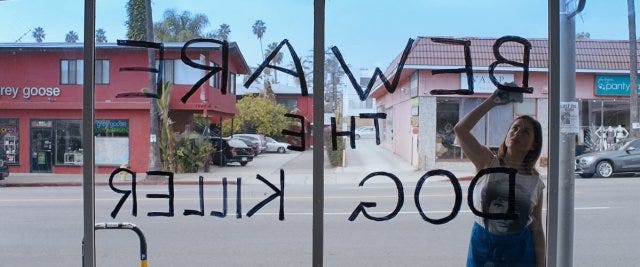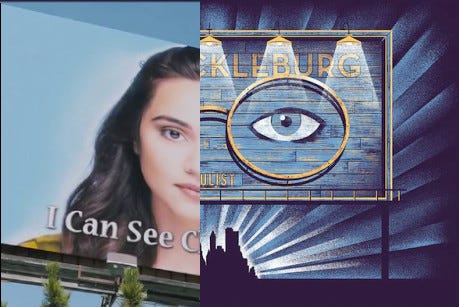Film Review: Under the Silver Lake
Aphopenics find connection between children's cereal and the illuminati.
Under the Silver Lake twists itself into a pretzel knot over its two hour and nineteen minute runtime. Like its protagonist, it is unfocused, driven, and frenetic. We open on an interior shot of a pretty cafe worker cleaning graffiti off the storefront windows. The graffiti reads:
“BEWARE THE DOG KILLER”
Our main character, Sam (played by Andrew Garfield of Spiderman fame), is staring out the window- whether he’s looking at her or at the graffitti is ambiguous. Sam is a real piece of shit. He drives a mustang in which he keeps a fake handicapped parking pass. He chain smokes cigarettes. He peeps on his female neighbors with binoculars. In fact, he constantly ogles women. He is on the verge of eviction from unpaid rent, and seems unmotivated and lazy in general. He admits to hating the homeless despite being a near-homeless layabout. He lies to his mom. Sam isn’t the sort of protagonist we normally root for.
This is a movie I want to lovely dearly and unconditionally, and I do enjoy it, but it is so glaringly masturbatory that I’m hesitant to recommend it to anyone I don’t already know is a film buff. There are, however, some things I love about it:
The fantastic score by Disasterpiece, who also did the soundtrack of one of my favorite games, Hyper Light Drifter.
The heavy noir elements really give me a dopamine dump. Sometimes it felt like I was getting to watch parts of Chinatown again for the first time. As a pastiche, UtSL gets everything right.
The film really takes LA’s obsessive oddness to task and asks if the insane are so out of place in a culture so obsessed with cache.
Almost every review you’ll read mentions how blown away they were by a scene in the middle of the film which impressively incorporates 20 or so pop songs in a mashup. I don’t know if I was particularly touched by it, but it was beyond technically impressive.
Hyper-Referential
UtSL is stuffed to the gills with reference, homage, pastiche. It’s no wonder since its director, David Robert Mitchell, also directed It Follows. If you’re unfamiliar, practically every scene in It Follows is an homage or reference to a famous horror movie. So to say there’s a rich undercurrent of sedimentary meaning in UtSL is an understatement. To get the most out of the film you’d either have to be a film student or a conspiracy buff, but ideally both.
From the outset, the majority of the movie is left ambiguous. Online I’ve seen it called a spiritual successor to Lynch’s Mulholland Drive, a dreamlike film that deals very specifically in showing us the interior world of a fractured mind and then sucker punches the audience with reality. UtSL cribs notes frequently from Mulholland Drive, leaving us to wonder if we are viewing Sam’s psychoses or the real world. To compound on this half-stated dreamyness there are many narrative strands woven throughout that we’re left to draw together ourselves:
The front and center fantastical “plot”, which is painstakingly spelled out for us in the final 20 minutes of the movie.1 It’s likely Sam’s paranoid delusion.
The “real life” version of events that we’re left to fill in from the negative space in the story. There are odd inclusions in the film seem like red-herrings to the actual plot2, but tell a secondary story of their own which is much sadder. 3
The Owl’s Kiss, a terrifying cryptid that seduces and kills residents of the LA basin. It kills the conspiracy-theorist-cum-zine-author that tells Sam about the monster in the first place, and then attacks Sam in his home. It flees when Sam points a gun at it, which is fair. It’s a pretty blunt metaphor for the paranoia, mental illness, and eventual suicide that grip Sam and other societal castaways.
The true “UtSL Mystery”- there is no way a movie littered with codes, secret messages hidden in plain sight, alternate meanings, and conspiracy won’t have a secret of its own to be hiding. The film has actually spawned a community set on discovering its true hidden “meaning,” which we’ll talk about a little later.
This film is both an aphophenic’s wet dream and worst nightmare. Repeated images pop up everywhere without much significance. A good example is the neapolitan trios of blonde, brunette, and redhead women:
The three female employees at the opening cafe? Blonde, brunette, redhead.
Sarah, who we spend the whole film tracking down, is the blonde of three female roommates who disappear, kicking off the events of the film.
Their empty apartment is visited by the blonde of another trio, who Sam follows to a rooftop concert.
There he encounters Balloon Girl, the brunette of yet another trio (that includes pre-Euphoria Sydney Sweeney!).
The band playing at the rooftop party? Jesus and the Brides of Dracula. Guess how many brides there are in the band? That’s right- three, gold stars all around.
It’s noteworthy that the Brides of Dracula themselves all either wear black wigs or have dark hair, breaking the “blonde, brunette, redhead” streak we see in the film’s female triads. Does this have significance? Maybe. Perhaps it’s a statement of the male gaze and objectification of women in hollywood that can only be broken by true artistic expression, or maybe it’s just a visual motif that David Robert Mitchell decided was fun to include, but decided not to enforce for his glam-goth plot device.
My strongest criticism of the film is that it tries to have its cake and eat it too: much of its runtime locked in an identity crisis (much like Sam) as to whether it wants to be an apophenic anthem or cautionary tale in finding meaning where there is none. Sam finds answers every time he dives deeper into the mystery of Sarah’s disappearance, but is left empty by the final revelation. Which is it, David? Do conspiracy nuts have deeper meaning to find in hidden messages in media, or is the search ultimately fruitless?
Memetic Hazard Detected
One unfortunate aspect of writing a film that discusses messages hidden in plain sight and secret meanings is that it’s basically a honeypot for people who will throw away countless hours digging into every nook and cranny of meaning the film has to offer. Maybe this was the intention, but one glance at the subreddit inspired by the film is enough to make it seem more like a sinister spider’s web that feeds on the attention of the same vulnerable individuals that get ensnared by the cinematic conspiracy theory universe Qanon.
The current top post on the subreddit (remember this movie takes place in LA) is a nearly 8 minute long video about references to 9/11 occurring at the same timestamp in many pre-2001 movies. The post is titled: “This movie set me down this path and lead to these discoveries. I worked very hard on this so please be nice.” One of the commenters said it best:
“I suggest a psychiatrist.”
Another more kindly wrote:
“no offense man but this is the exact kind of behaviour the movie is parodying and dissecting”
There’s interesting thought to be had around the relevance of UtSL and its subreddit to Poe’s Law, which states that sans authorial intent any parody of extreme views can be mistaken for a sincere expression of the views being parodied. This is where I think that the films hyper referential, masturbatory nature and David Robert Mitchell’s tendency to overstuff his work with homage really get in the way of UtSL. As I said above, the film tries to have its cake and eat it too- what I mean by this is that a message of “chasing conspiracy theories is meaningless” is thoroughly drowned out by “look at all the fun little clues we left in here for you conspiracy buffs.”
I don’t personally believe we as artists and creators have a responsibility to avoid any topic, even one that might send someone to madness. If someone was going to go mad it isn’t really your fault for producing the straw that broke the camel’s back. But Mitchell is poking the bear by overloading the film with marginalia of zodiac ciphers, geolocations, hidden messages, and cryptic LA geography lessons. The UtSL subreddit is testimony to the fact that the film’s navel gazing has somewhat tainted the legacy of what could have gone down as an oeuvre on par with Lynch’s Mulholland Drive, rather than a shadow of it.
Conclusion
Overall, if you’re a movie fan and are willing to sit down for a confusing but fun and wild ride, I recommend Under the Silver Lake. If you have a history of schizophrenia or paranoid thinking, I would steer clear of it. If you are just looking for something entertaining that you won’t have to think about, this isn’t the movie for you.
Rich men throughout history, including ancient egyptian pharaohs, have belonged to a shadowy cult that promises real eternal life after death by being entombed with their wives (always three) in a pyramid underground to await “ascension.” In order to keep it secret, communication about the cult has been hidden in plain sight via coded messages implanted into popular culture.
The frequent mention of the dog killer,
Sam’s fixation on a gatsbyesque billboard for contact lenses,
his inability to pay his rent,
a scene in which Sam violently assaults a trio of kids for vandalizing his car,
Sam’s near constant voyeurism,
his frequent hallucinations of women barking instead of talking,
an awkward conversation at a party he is led to by a coyote,
the dog treats he keeps in his pocket, and a stolen conversation at the end of the film about these treats.
Sam experienced some sort of schizoid break around the time his long term partner, who had a dog, left him. This long term partner is the women on the contact lens billboard. He is the dog killer, and has been murdering dogs to get back at his ex, and women in general. It’s left ambiguous as to whether he knows that he has the alternate persona, but it’s hinted at in the final two scenes of the movie- in which the Homeless King seems to accuse Sam of being the dog killer, but lets him go anyways, only to graffiti the interior of Sam’s apartment with the hobo code for “Keep Quiet” that we’ve seen throughout the film. The film closes on Sam seeing his landlord reacting to this graffiti and smiling sinisterly- the smile of someone who’s finally been recognized for their true (evil) self.







